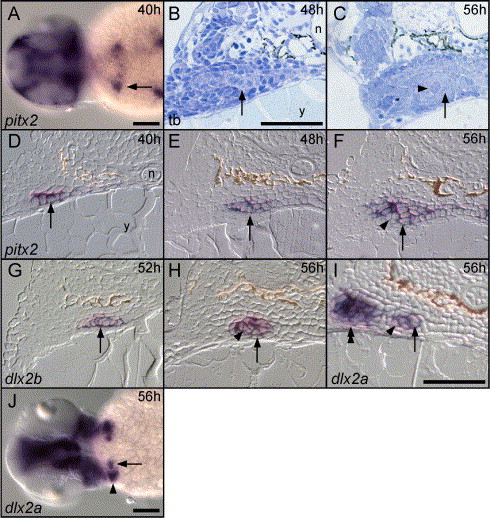Fig. 3 pitx2 expression is the earliest indicator of zebrafish tooth development, and Dlx2 orthologs the earliest specific tooth markers we identified. (A) At 36 h (40 h shown), pitx2 is expressed broadly in the pharyngeal epithelium, with the strongest expression prefiguring the first tooth germs (arrow, dorsal view, anterior to the left). (B) At 48 h, the dental epithelium has begun to thicken and undergo morphogenesis (arrow). (B–I) Transverse sections oriented as in Fig. 2I. (C) By 56 h, the tooth germ has undergone morphogenesis with the dental epithelium (arrow) surrounding a core of mesenchyme (arrowhead). (D) At 40 h, pitx2 is expressed in the pharyngeal epithelium (arrow), but no sign of dental morphogenesis is yet visible. (E) At the beginning of dental morphogenesis at 48 h, pitx2 expression is maintained in the pharyngeal epithelium (arrow). (F) At 56 h, pitx2 expression continues in the pharyngeal epithelium, including the dorsal and medial dental epithelium (arrow) adjacent to the non-expressing mesenchyme (arrowhead). (G) dlx2b expression is first detectable in the dental epithelium at 48 h (arrow, 52 h shown), and continues to be expressed in the epithelium (arrow) and mesenchyme (arrowhead) at 56 h (H). (I and J) dlx2a is expressed in the dental epithelium (arrows) and mesenchyme (arrowheads) at 56 h, but in contrast to dlx2b, is also expressed in lateral arch mesenchyme (double-arrowhead). Labels: n = notochord, y = yolk. Scale bars = 100 μm.
Reprinted from Developmental Biology, 274(1), Jackman, W.R., Draper, B.W., and Stock, D.W., Fgf signaling is required for zebrafish tooth development, 139-157, Copyright (2004) with permission from Elsevier. Full text @ Dev. Biol.

